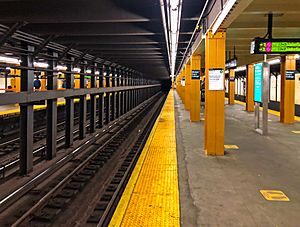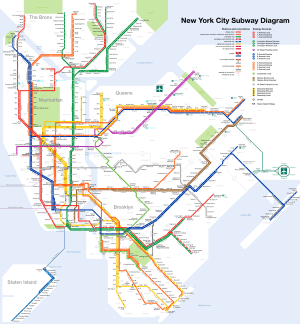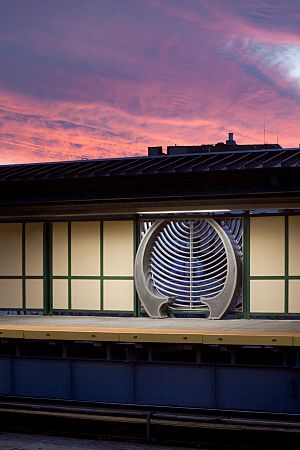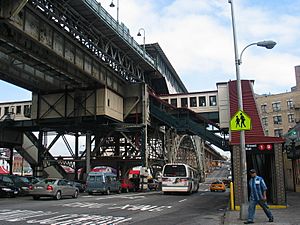New York City Subway facts for kids
The New York City Subway is a huge train system in New York City, United States. It's run by the Metropolitan Transportation Authority (MTA). It's one of the biggest train systems in the world, with 472 stations. It has 245 miles (394 km) of routes and 691 miles (1112 km) of railway track. The New York City Subway almost never closes. Trains run 24 hours a day, 7 days a week, all year long! The system has only closed three times. This happened during the September 11 attacks and when Hurricane Sandy flooded its tracks.
The first trains that ran above ground started on October 9, 1863. The first underground trains began on October 27, 1904.
Contents
History of the NYC Subway
Alfred Ely Beach built an underground subway tunnel in 1869 to test a new idea. His Beach Pneumatic Transit was only 312 feet long under Broadway in Lower Manhattan. The subway car in this tunnel was moved by air, like a vacuum. This tunnel was never made longer.
The first underground subway line opened on October 27, 1904. But the oldest elevated train line in the subway system opened even earlier, in 1885. The very first tracks used by the subway were for a steam railroad called the Brooklyn, Bath and Coney Island Rail Road, which opened in 1863.
Early Subway Companies
When the first subway opened, there were two main private companies. These were the Brooklyn Rapid Transit Corporation (BRT) and the Interborough Rapid Transit Company (IRT). After 1913, the New York City government started building most new subway lines. They then let the private companies use these tracks. In 1932, the city opened its own subway system called the Independent Subway System (IND).
In 1940, the city bought the two private subway systems. Some of the old elevated train lines were closed and taken down. In 1953, the New York City Transit Authority (NYCTA) was created to run the subway, buses, and streetcars. It became part of the Metropolitan Transportation Authority in 1968.
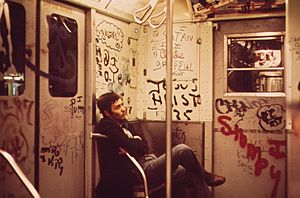
Subway Changes Over Time
By the 1970s and 1980s, riding the New York City Subway was not very good. Not many people were using it. There was a lot of graffiti and crime on the trains. This problem was fixed in the 1990s, and the subway became much better.
After the September 11 attacks in 2001, some train lines in Lower Manhattan had to stop running for a while. In 2012, Hurricane Sandy caused a lot of flooding in the subway system. Many lines closed for a few days, but they were fixed and reopened.
Subway Stations
Subway stations are found in Manhattan, Brooklyn, Queens, and the Bronx. About 40% of the subway tracks are above ground, and 60% are underground. Every day, about 5,076,000 people ride the subway. Out of 472 stations, 463 are open all the time.
Inside a Subway Station
Many stations have "mezzanines." These are areas where you pay your fare before you go down to the train platforms. Everyone must pay to enter the subway system. Mezzanines are usually between the street level and the train platform level.
Many station entrances have lamp posts with colored balls on top. A green ball means the entrance is open 24 hours a day, every day. A red ball can mean two things: either the entrance is only open part-time, or it's only an exit. Sometimes, these globes don't show the correct information.
Most subway stations have platforms where people wait for trains. These platforms are usually between 480 and 600 feet long. All new stations have platforms with air conditioning.
Many stations also have artwork on their walls. Most stations were built before 1990. That's when a new law said that many new public buildings, like subway stations, should have elevators and ramps. This helps people who use wheelchairs to enter these buildings easily.
Since 1987, the MTA has had a program called "Music Under New York" (MUNY). Musicians have to try out to be allowed to play music in a station. Now, there are over 100 musicians and performers in the subway system.
There are only 129 open restrooms in 77 of the subway stations. Some platforms also have newspaper stands that sell newspapers and food. There are also stores in some stations.
Subway Lines and Routes
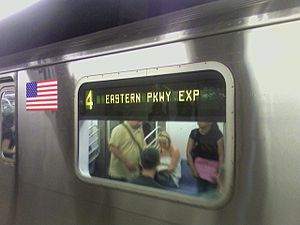
In New York City, a subway "line" is the actual set of tracks. A train "route" is the path a train takes using those tracks. Routes are called "services" and have a letter or a number, like "1" or "A." Lines have names, like BMT Broadway Line.
There are 24 train services, including 3 "shuttle" routes. Each route has a color on the subway map. A lawyer named Raleigh D'Adamo planned these colors in 1964. Before that, maps used different colors for every single route. People who live in New York City usually don't call routes by their color (like "Blue Line"). However, tourists often use colors to tell routes apart.
Types of Subway Services
There are three main types of subway services:
- Local trains stop at every station on their route.
- Express trains skip some stations, only stopping at bigger "express" stations.
- There is one "skip-stop" service, the J/Z. On this line, two different train routes run on the same tracks. Each route only stops at every other station along the line.
The subway system runs 24 hours a day, 7 days a week. However, some routes do not run when not many people are riding the subway, like late at night. If a line is closed for repairs, the subway system uses free shuttle buses. The subway authority shares information about planned service changes on its website, on station walls, inside subway cars, and on its Twitter page.
Subway Routes List
There are many routes on the subway. It can be confusing because there are so many routes going to different places. The subway has signs hanging from the station ceilings to show the routes and where they go.
Subway Fares
From 1904 until 1948, people paid a nickel (five cents) to ride the subway. On July 1, 1948, the price went up to a dime (ten cents). In July 1953, the fare was raised to 15 cents. The MTA used to give out subway tokens, which people used to enter. People stopped using tokens in 2003.
Today, the fare is $2.75. Riders must pay with MetroCards or OMNY. The subway started using MetroCards in 1994. You can buy MetroCards at subway stations from booths or vending machines. You can also buy them from many stores in New York City. OMNY started in 2019 as a test. It lets you pay for your subway ride using credit or debit cards. It worked well and is now available throughout the subway system. OMNY is planned to replace the MetroCard by 2024.
Rider Safety on the Subway
Riders are allowed to take pictures with cameras. However, they are not allowed to use cameras that flash or cameras on tripods.
Subway police can search riders to make sure they do not have weapons or other items that could hurt people.
When riders get hurt, it's often because they slip when getting on or off the train. This happens because there can be a gap between the train and the platform. Recently, workers have made these gaps smaller to help prevent slipping. You will often hear messages from loudspeakers saying, "Please watch the gap when entering and exiting the train."
Train Safety and Operation
The MTA works hard to make sure New York City Subway trains run safely. There are railroad switches, railroad signals, and speed limits on the subway tracks. All tracks also have a stopper on the side. If a train goes past a red signal, this stopper will automatically stop the train.
A black-and-white striped board hangs above the middle of each platform. The train conductor has to point to this board. After the conductor points to the board, the train doors will open.
The subway has had over 56 train accidents since 1918. The Malbone Street Wreck on November 1, 1918, was the deadliest. That crash killed 93 people.
Since the late 1990s and early 2000s, the MTA has been trying out Automatic train operation. New York City Subway trains usually have a train conductor and a train operator. In 2006, the L train was the first route to be run by computers. The 7 train is becoming the second route to be run by a computer. There are computers both on the train and along the tracks. The computer does the engineer's job by driving and stopping the train.
Images for kids
-
The City Hall station of the IRT Lexington Avenue Line, part of the first underground line that opened on October 27, 1904
-
125th Street station on the IRT Broadway–Seventh Avenue Line
-
The long and wide mezzanine in the West Fourth Street station in Greenwich Village
-
Driver's cab of an R160B subway car on the N train
-
Example of a wayside block signal at the 34th Street–Hudson Yards station
-
28th Street station after the W train was discontinued in mid-2010. Note the dark grey tape masked over the W bullet. (This sign has since been replaced due to the restoration of the W in 2016.)
-
Disinfection of New York City Subway cars against coronavirus during the COVID-19 pandemic in New York City
-
An advertisement for Miss Subways at the New York Transit Museum
-
Preparations for Hurricane Sandy at Bowling Green
-
Pump train in the Cranberry Street Tube after Hurricane Sandy
See also
 In Spanish: Metro de Nueva York para niños
In Spanish: Metro de Nueva York para niños


